PrestaShop Vs Shopify: Which One Is Better For Dropshipping?
I'm looking for...
Are you ready to dive into the world of dropshipping but unsure which platform to choose? In my upcoming blog article, I’ll unravel the debate between PrestaShop vs Shopify, exploring which one reigns supreme for your online venture.
From streamlined setups to seamless payment processing, each platform brings unique strengths to the table.
Join me as I delve into the nuances of PrestaShop and Shopify, shedding light on their features, pros, and cons.
Whether you’re a budding entrepreneur or a seasoned business owner, this article will help you navigate the labyrinth of e-commerce platforms and make an informed decision. Stay tuned!
Create Your Online Store in just 5 Minutes – For Free
Pick your niche, our AI builds your store, add 10 winning products and we teach you how start selling today. Start picking your niche
What Is PrestaShop?

PrestaShop is a great free tool for small and medium-sized stores to begin selling stuff. Think of it as a fancier version of WordPress or similar free platforms but with lots of features for bigger stores.
You’ve got loads of tools to make your online shop look just how you want. It might take a bit more effort compared to Shopify or Squarespace, but if you’re okay with that, PrestaShop can give your products a cool home online.
What Is Shopify?

Shopify is definitely the go-to choice for making online stores. Since it started, Shopify has helped almost a million stores make over $100 billion in sales.
You get lots of tools to make your store just right, plus stuff to help you keep track of stock, get paid, and see orders. It’s all there to help you build, tweak, and grow your online shop.
PrestaShop Vs Shopify: Quick Review

The best
- PrestaShop is free; you can create as many online shops as possible.
- It’s easy to use and set up, whether you install it automatically or manually.
- Numerous themes and modules to choose from.
- It can speak around 75 languages and handle different types of currencies
The worst
- It get difficult to handle your store as it grows.
- It could be challenging if you want a really special store design
- You need to learn more about making websites.
- You must pay about $300 if you need more help from their team
Starting from
- No Subsrciption needed; Includes costs like your domain name, hosting, and SSL certificate for your e-commerce site.

The best
- Excellent eCommerce functionality
- Advanced SEO capabilities
- Multi-currency selling
- Automatic tax calculation
The worst
- Charges Transaction fees
- Limited Storage space
- Limited customization options in some ways
Starting from
- Shopify Basic Plan – $32 per month; Shopify Regular Plan – $92/month; Shopify Advanced Plan – $399/month
How Does PrestaShop Work?
So, the first thing I will discuss in this PrestaShop vs Shopify review is how each of them works.
Setting up PrestaShop
Manual Installation: To set up PrestaShop manually, you can download the latest version and use an FTP client to install it.
Auto-Installer Method: Alternatively, you can use an auto-installer on your web hosting control panel for an easier setup process.
1. Accessing Hostinger’s Auto Installer
Go to hPanel -> Auto Installer and select “Other”.
2. Selecting PrestaShop
In the “Search an application” section, choose PrestaShop and click “Select”.
3. Inputting Details
Enter your Website Title, Administration Username, Email, and Password, then click “Next”.
4. Choosing Version and Update Schedule
From the dropdown menu, select the latest version of PrestaShop and your preferred update schedule.
5. Finalizing Installation:
Tap the “Install” button to complete the process.
6. Accessing Dashboard
- To access your website’s Dashboard, navigate to hPanel -> File Manager and locate the folder with 16 random letters.
- Open a web browser and add the random letters to your domain (e.g., http://yourdomain.com/afnujbcvu5lpgkvd).
- Log into your PrestaShop account using your Email and Password.
Navigating PrestaShop Dashboard
Upon logging in, you’ll find various built-in features and tools accessible from the Dashboard, including:
- Orders
- Catalog
- Customer Service
PrestaShop also offers insights into your store’s growth through:
- Activity Overview
- Products and Sales
So, once installed, you can access the PrestaShop dashboard to manage various aspects of their store, including orders, catalog, and customer service.
The platform offers built-in features and tools for store management and growth, along with options to customize the store’s appearance and functionality.
How Does Shopify Work?
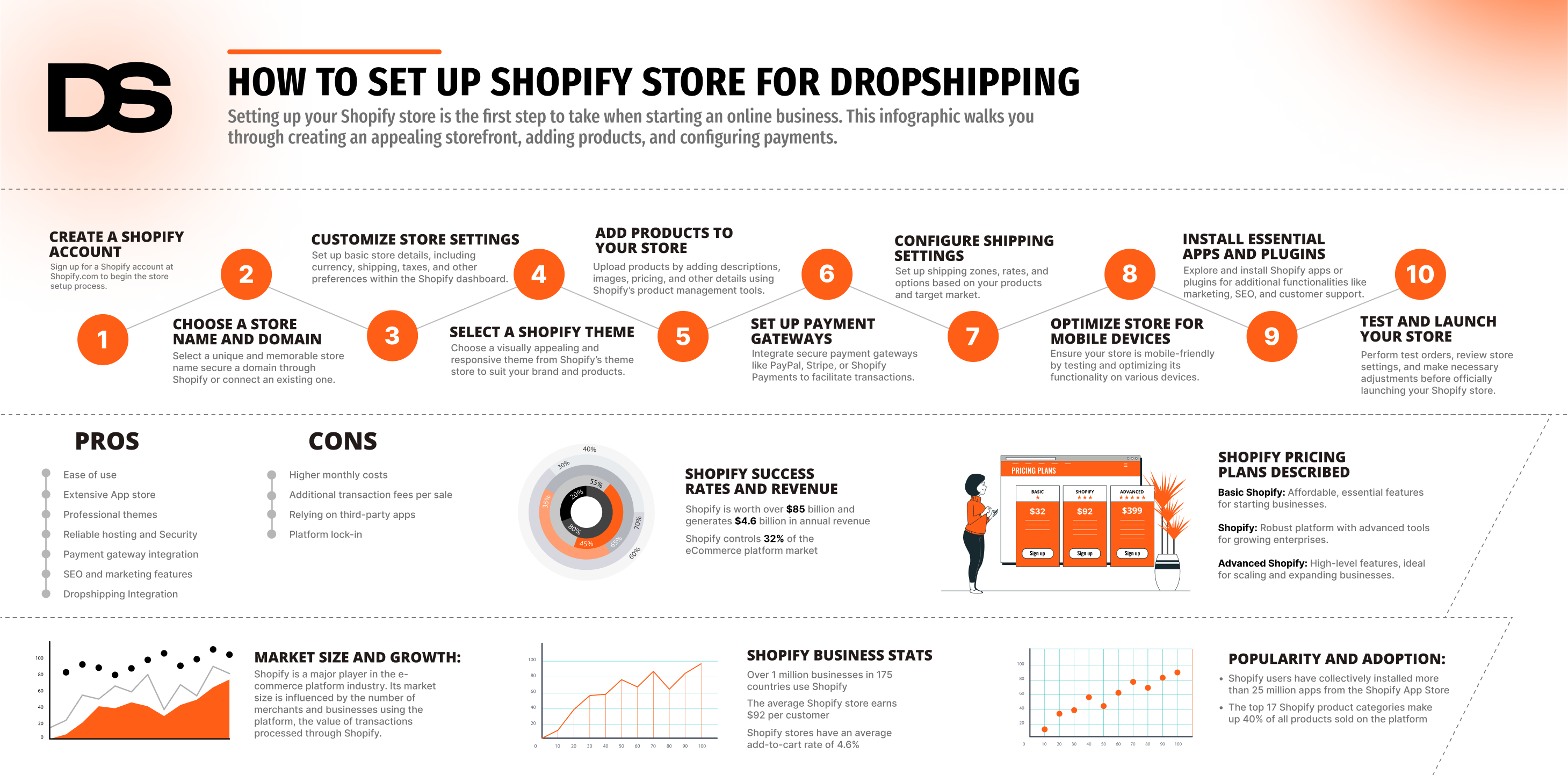
1. Sign Up for Shopify
- Go to the Shopify website and sign up for an account.
- Choose a unique store name and enter your email, password, and other required details.
- Start your free trial to begin setting up your store.
2. Set Up Your Store
- After signing up, you’ll be directed to the Shopify admin dashboard.
- Complete the setup process by entering your store details, such as store name, address, currency, and industry type.
3. Add Products
- To add products, navigate to the “Products” section in the admin dashboard.
- Click on “Add product” and fill in the product details, including title, description, price, and images.
- You can also categorize products into collections for easier navigation.
4. Customize Your Store’s Design
- Shopify offers various customizable themes to choose from. Navigate to the “Online Store” > “Themes” section in the admin dashboard.
- Browse through the available themes and choose one that fits your brand.
- Customize the theme by adjusting colors, fonts, and layout to match your branding and preferences.
5. Set Up Domain Name
- Purchase a custom domain name for your store to give it a professional appearance.
- You can buy a domain directly through Shopify or connect an existing domain if you have one.
6. Configure Payment Gateways
- Shopify supports multiple payment gateways, including Shopify Payments, PayPal, Stripe, and others.
- Set up your preferred payment gateways in the “Settings” > “Payments” section.
- Enter your bank account details to enable payouts.
7. Set Up Shipping
- Configure shipping settings based on your business needs and location.
- Define shipping zones, rates, and shipping methods in the “Settings” > “Shipping and Delivery” section.
8. Launch Your Store
- Once you’ve added products, customized your store, and configured settings, you’re ready to launch.
- Preview your store to ensure everything looks good, and if it is ready click “Launch”
👉 Learn How To Set Up Your First Store On Shopify [For Dropshipping Beginners].
Prestashop Vs Shopify: Key Features
Ease of use
PrestaShop Ease Of Use
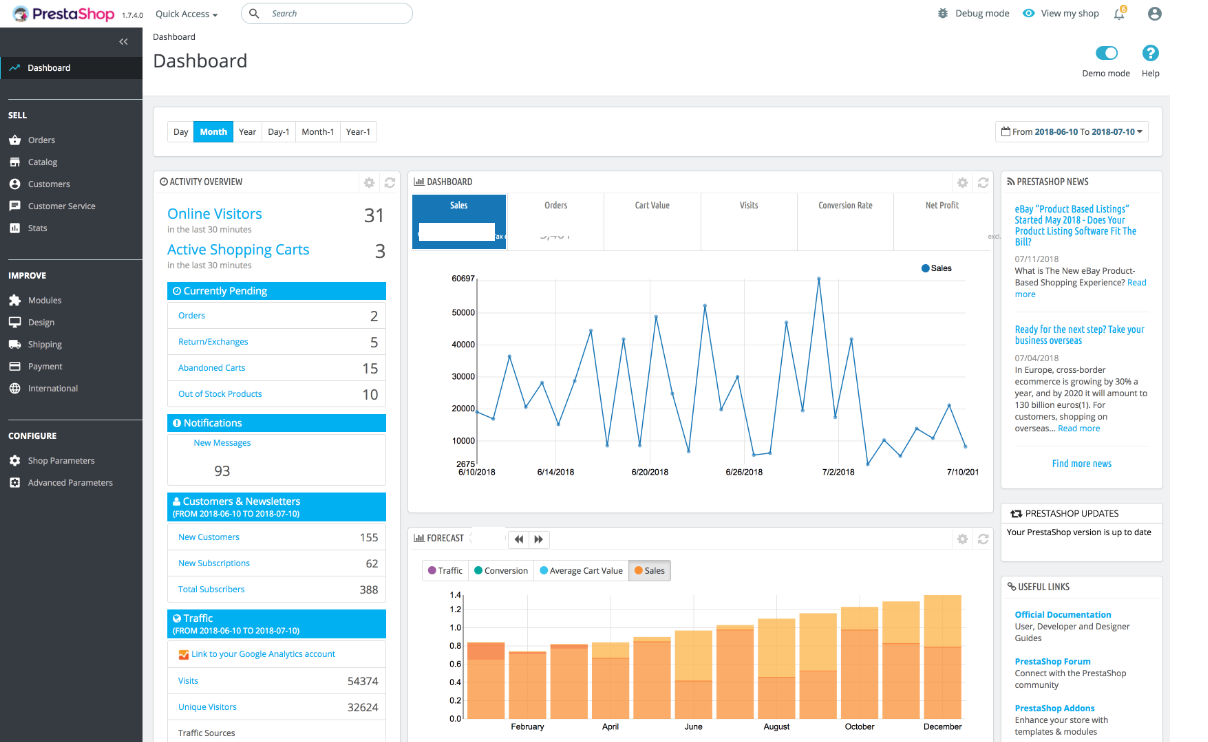
Starting an online store with PrestaShop is possible even if you’re not super tech-savvy, but creating a more advanced store might require some coding know-how.
In the Dashboard, you’ll find built-in features like Orders, Catalog, and Customer Service, along with sections to track your store’s growth.
There’s also a Quick Access button for common tools and an option to customize which tools appear there. Overall, building a store with PrestaShop is more complex compared to Shopify.
Shopify Ease Of Use
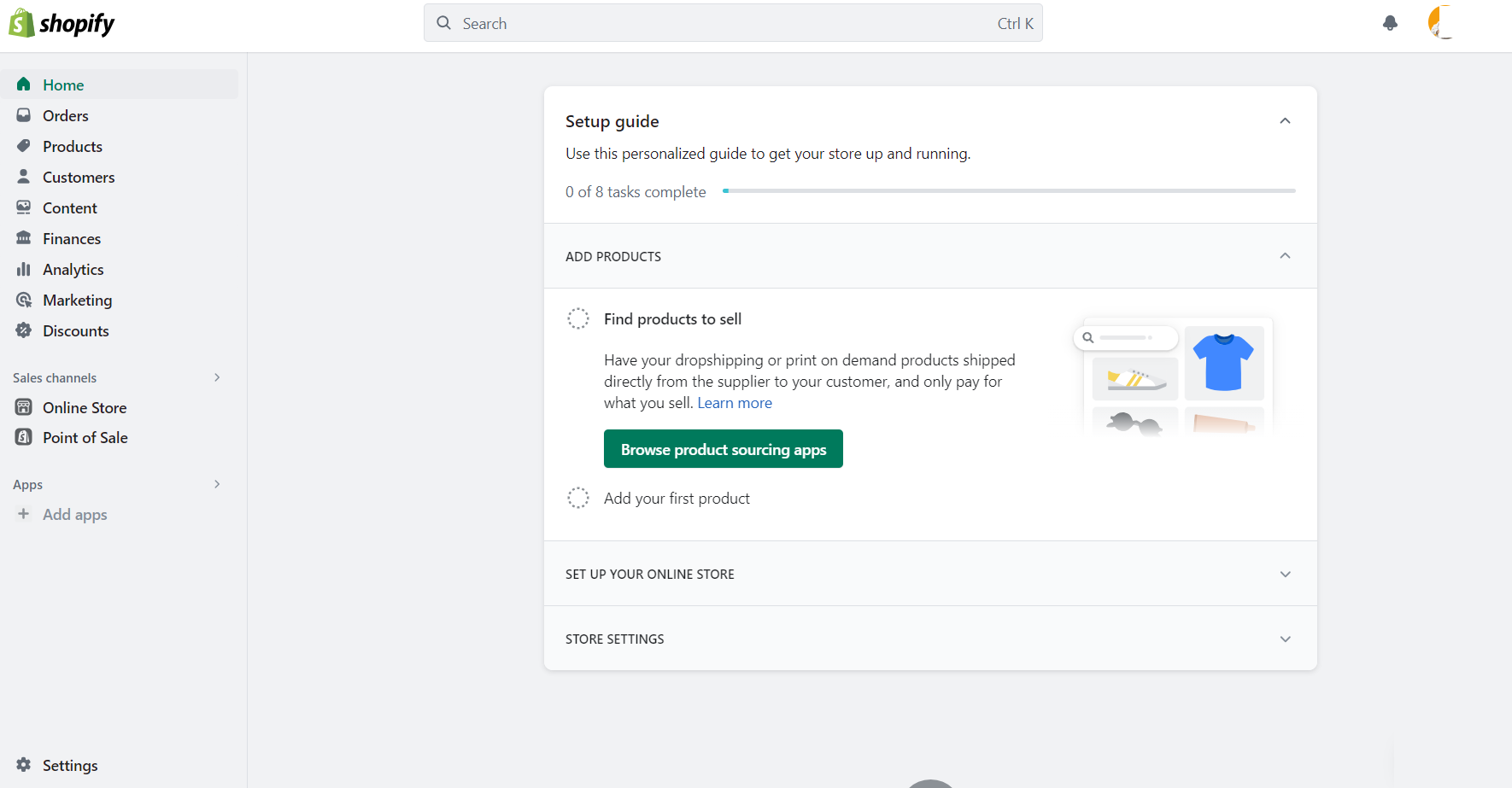
Shopify is famous for being easy to use, making it a top pick for beginners and pros alike. Its interface is user-friendly and intuitive, making it a breeze to navigate and manage your store.
Setting up shop on Shopify is quick and straightforward, thanks to its step-by-step guide. Hence, it requires a few easy steps like providing your email, password, store name, and several quick questions.
So, once you are in their dashboard, all information is well-organized in categories.
Plus, you’ll also have access to a variety of pre-designed themes, which you can easily customize with their drag-and-drop editor to match your brand’s unique style.
Prestashop Vs Shopify: Themes & Customizability
PrestaShop Themes & Customizability
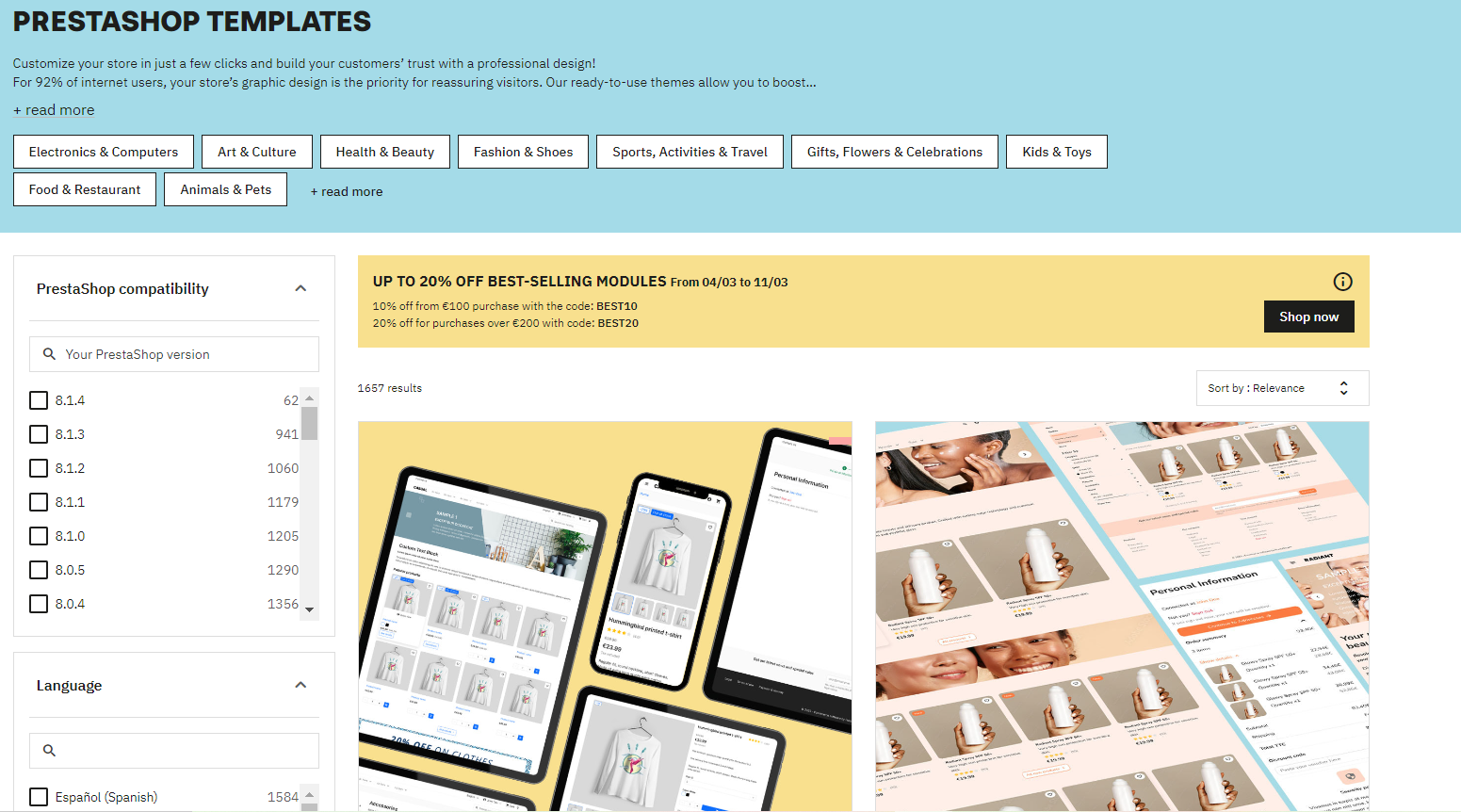
With PrestaShop, you can easily access and modify all the codes of their themes, allowing you to customize your shop exactly how you want it.
This flexibility helps your store stand out, giving it a unique look and user experience.
If you’re not comfortable with coding, don’t worry! PrestaShop offers over 1,657 templates that you can use as a starting point and tweak to fit your shop’s needs.
Shopify Themes & Customizability
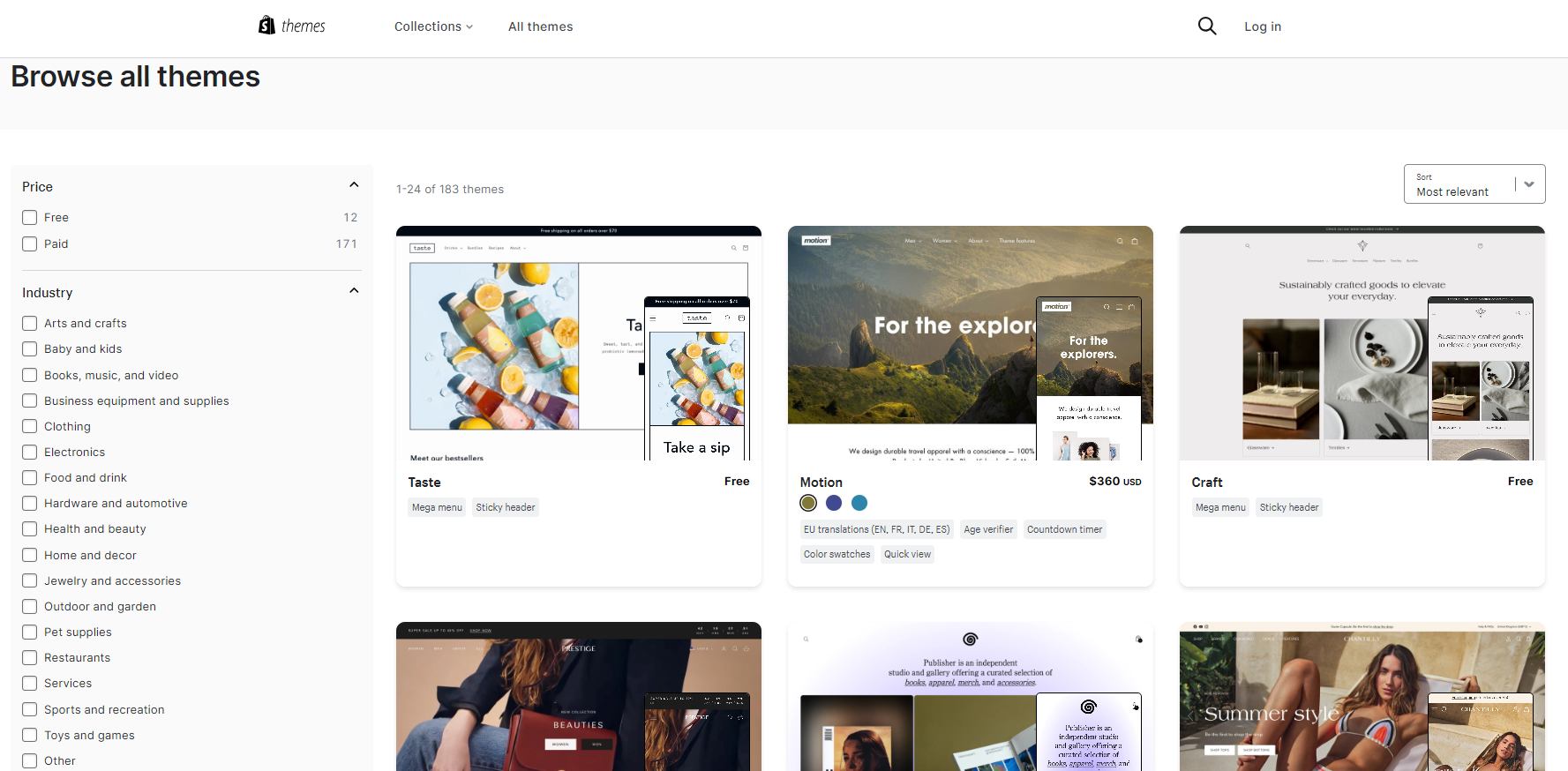
Shopify provides over 183 pre-made themes, both free and paid. These themes give you the flexibility to adjust, add, rearrange, or temporarily hide sections and blocks, giving you full control over your dropshipping store’s key features.
So, using the Shopify drag-and-drop editor makes the whole process easy. You can also personalize your store’s appearance by changing typography and colors.
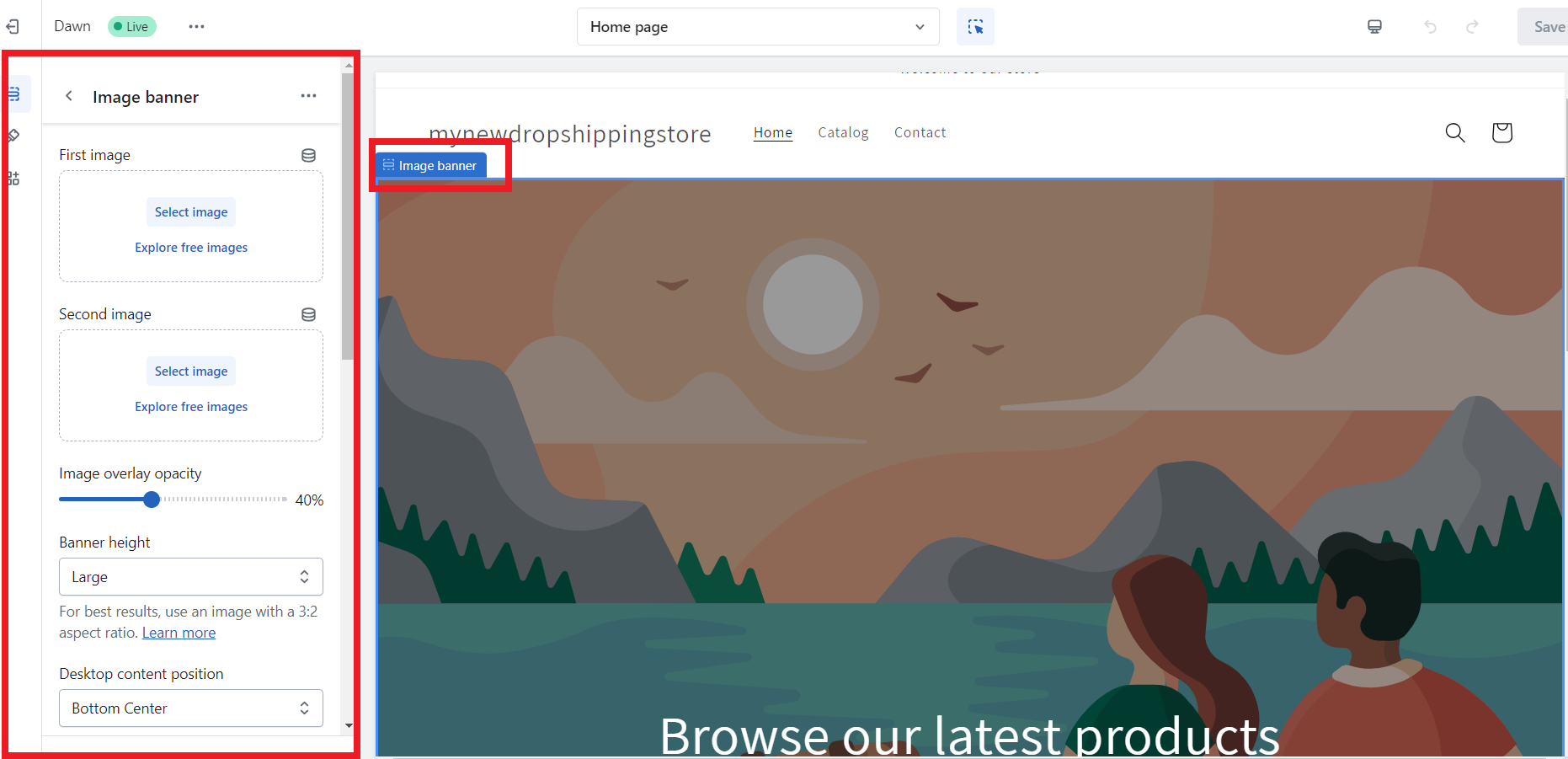
So, simply navigate to the “Theme Settings” section in the left sidebar menu, represented by a brush icon.
Additionally, you can create multiple landing pages, and image sliders, customize your footer, and more, to match your preferences.
Prestashop Vs Shopify: Security
PrestaShop Security
The platform takes security seriously and provides a PCI-certified download file to ensure your information stays safe. They offer various security modules to enhance overall store security.
Furthermore, with PrestaShop, you can bolster security using add-ons and code. Users can hide important files using .htaccess to prevent unauthorized access.
Also, security modules like Security Pro and Google Authenticator further enhance store security without the need for complex coding.
Shopify Security
Shopify is designed to provide a secure environment for running your online store. They offer a free SSL certificate to ensure secure connections to your store and encrypted information.
Shopify also automatically updates systems to safeguard against potential issues.
Moreover, every Shopify store comes with a Level 1 PCI DSS certificate, which is significant for businesses handling card payments as it ensures the security of all data and customer information.
Thus, the platform prioritizes the protection of your sensitive data and takes additional measures to ensure everything remains secure while you manage your online shop.
Prestashop Vs Shopify: Apps
PrestaShop Apps
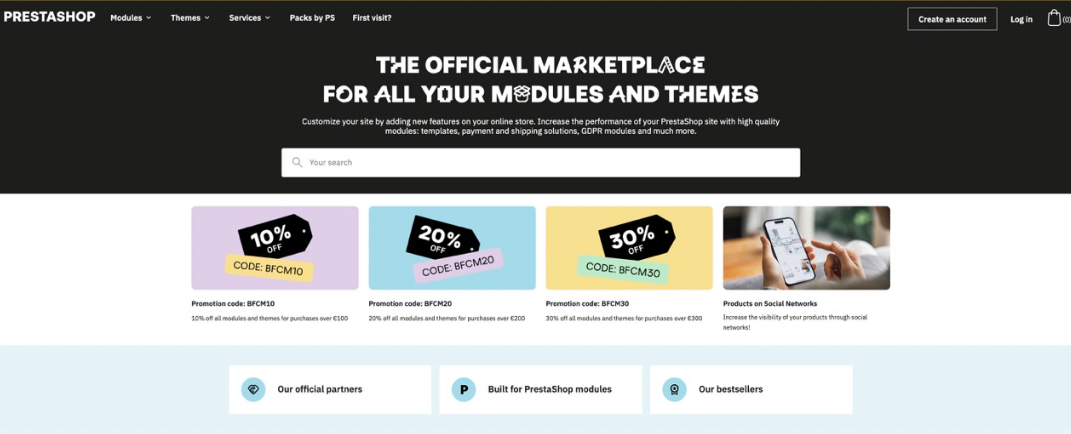
The addons marketplace boasts over 5000 modules designed to enhance your website’s functionality. These modules enable customers to customize their online store, increase sales, build trust, and foster customer loyalty.
Developed by PrestaShop, these modules also help you improve conversions, enhance productivity, optimize your site, and create the best possible ecommerce experience, among other purposes.
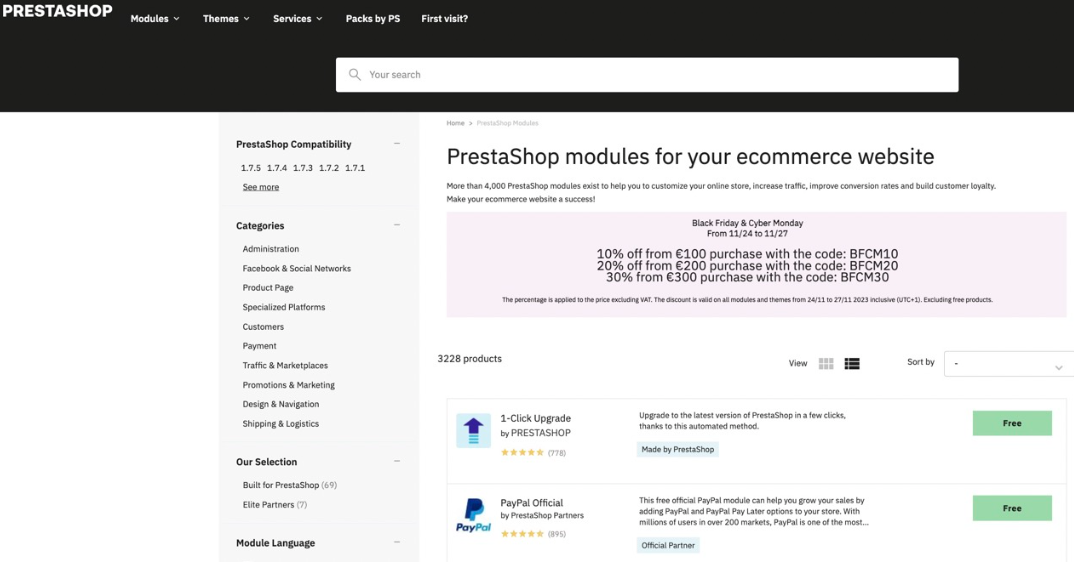
Thus, the modules are divided into several categories, like:
- Product Page
- Design & Navigation
- Promotions & Marketing
- Traffic & Marketplaces
- Payment
- Shipping & Logistics
- Administration
- Customers
- Facebook & Social Networks
- Specialized Platforms
Also, when it comes to pricing, you can discover some modules for free. However, most add-ons come with a price, starting from $30 to $50 for basic ones.
The more advanced features you need, the higher the price goes, ranging from $80 to $100.
Also, modules with top-notch features, designed for big companies, can cost anywhere between $250 and $550.
Shopify Apps
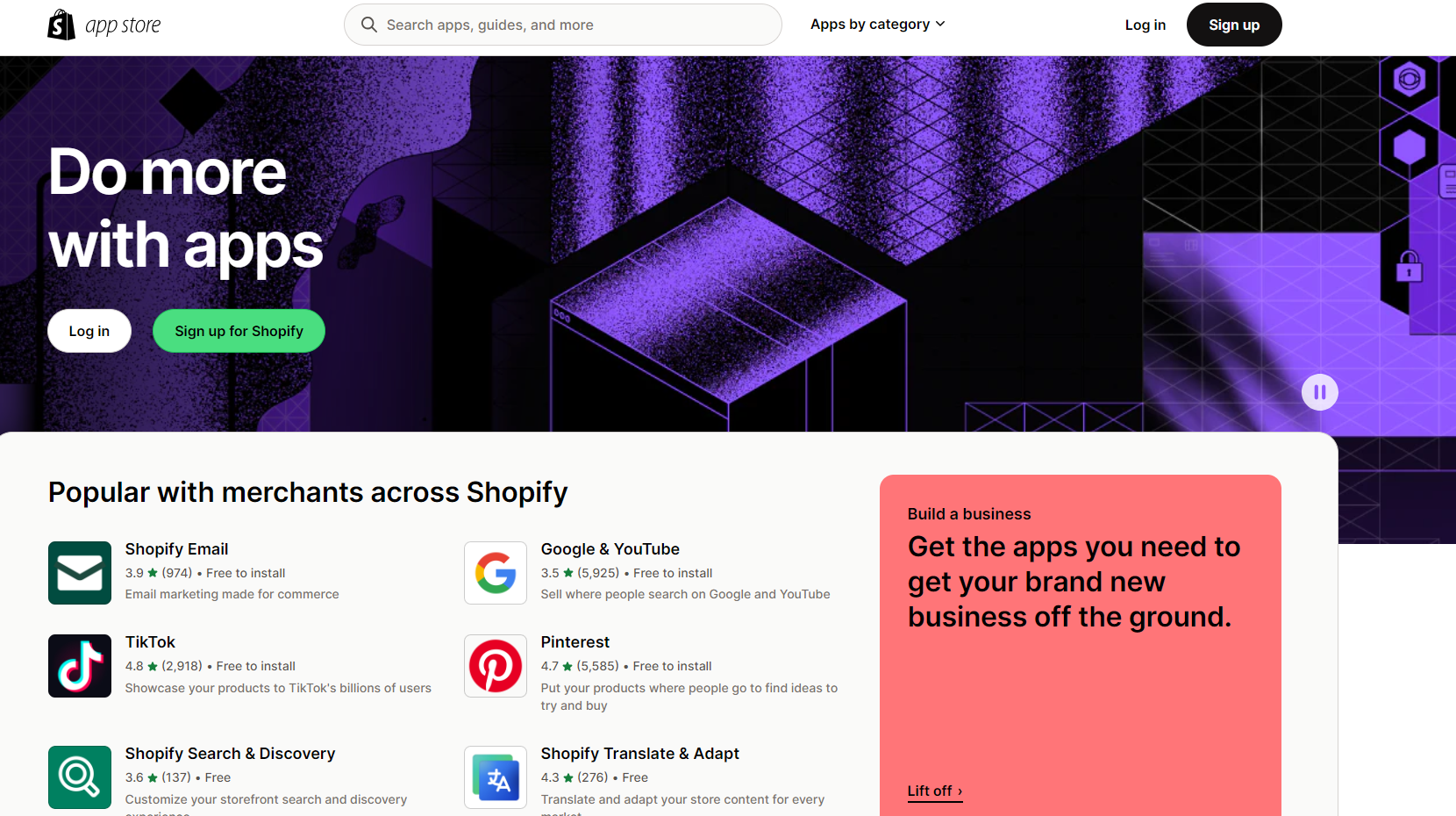
Shopify provides approximately 4000 eCommerce applications that can enhance and expand different aspects of your business, from inventory management to marketing and customer support.
It offers a comprehensive range of tools to cater to all your business needs. Moreover, the price range for their third-party apps ranges from free to hundreds of dollars.
Conveniently, you can access the Shopify app store directly from your dashboard or explore various applications that suit your specific requirements by navigating to the Shopify app store effortlessly.
Prestashop Vs Shopify: Marketing & SEO
PrestaShop
In PrestaShop, you have to install modules separately for SEO instead of having built-in SEO marketing tools.
However, PrestaShop offers handy features such as making coupons, discounts, special offers, suggesting related products, and showcasing products.
Additionally, you can craft a catchy title and description to improve your product page’s visibility and change the URL to make it easier for users to find.
Moreover, PrestaShop includes SEO tools, functions to send emails for abandoned carts, links to social media platforms, and detailed reports.
It allows you to create customer databases and form customer groups to customize the shopping experience, handle customer service inquiries, and reply to messages.
Shopify
Shopify dominates when it comes to SEO tools and advanced features. Meta descriptions, titles, headings, and much more are fairly simple and easy to manage compared to other platforms. Plus, you can even improve your SEO on product pages.
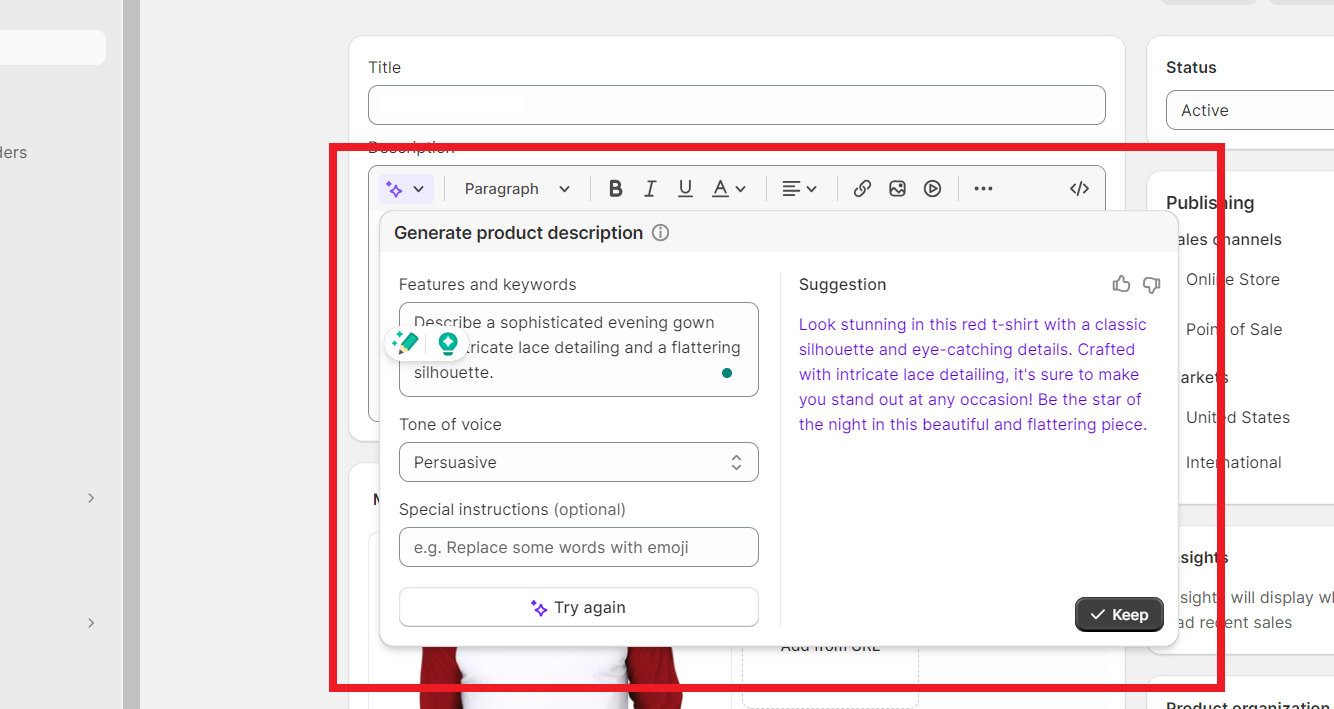
Not only that, but the platform provides numerous integrations with marketing apps for social media ads, email marketing, SEO, retargeting, building loyalty programs, upselling, cross-selling, and many more.
Plus, it includes coupons, discounts, etc.
👉 Learn How To Add Favicon On Shopify In Minutes.
Prestashop Vs Shopify: Payment Gateways
PrestaShop Payment Methods
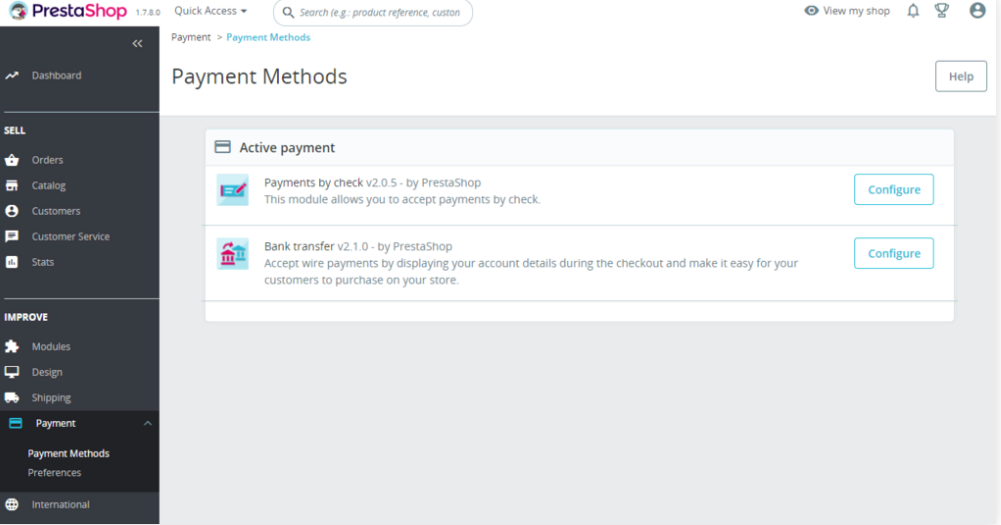
This platform comes with two built-in payment options: Payment by check and Bank transfer, allowing customers to pay in more traditional ways.
Additionally, PrestaShop offers payment modules that you can install to expand payment options in your store.
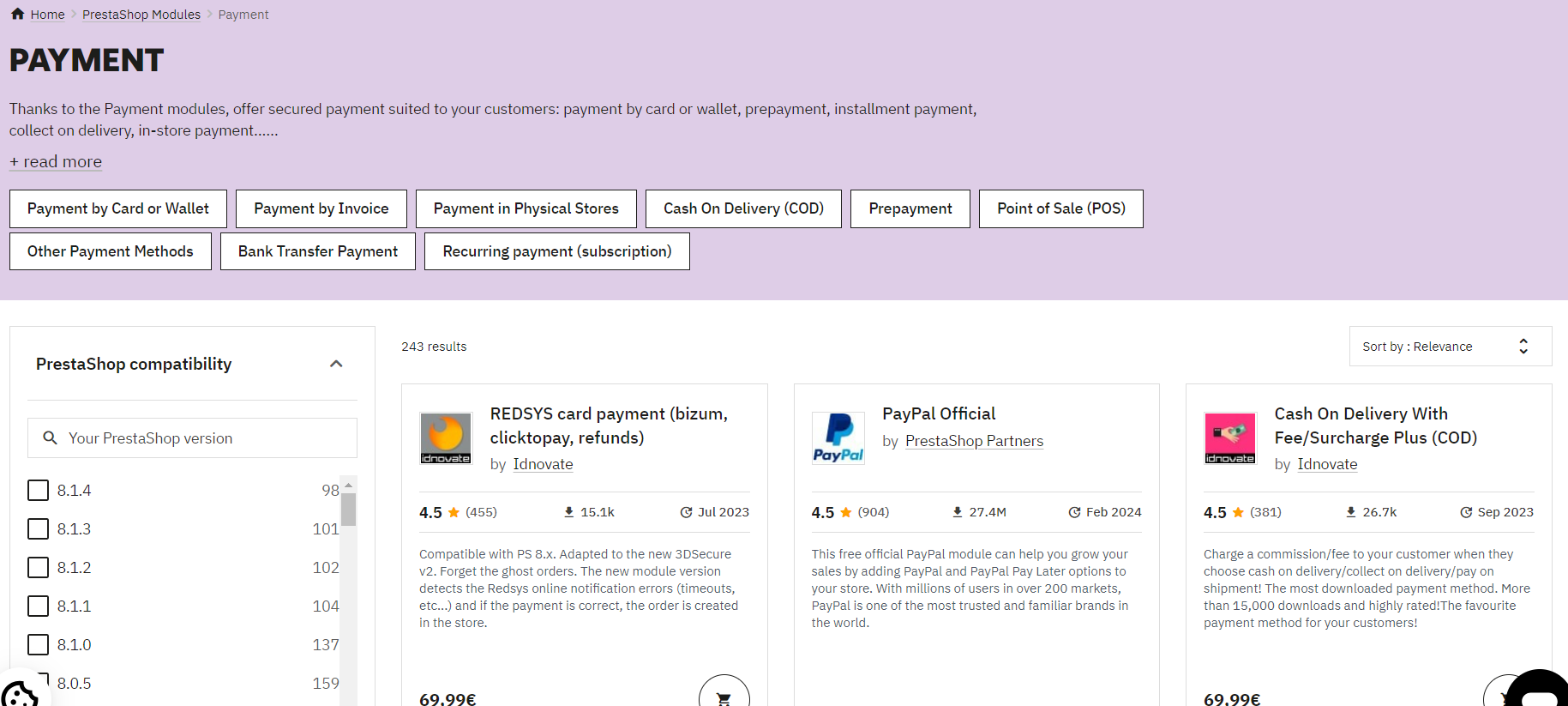
These modules include popular ones like PayPal for secure online transactions and Cash on Delivery, where customers pay upon delivery. Moreover, you can find payment by invoice, prepayment, POS, etc.
When it comes to transaction fees, PrestaShop’s Checkout module applies charges based on the chosen payment method:
- PayPal transactions have a fee of 2.9% plus €0.35 per transaction.
- Credit and debit card transactions come with a fee of 1.2% plus €0.35. American Express payments, although expected soon, might have a 3.5% fee plus €0.35.
- Cross-border transactions within the Eurozone charge an additional 0.5%, while those involving other countries incur a 2% fee.
Shopify Payment Options
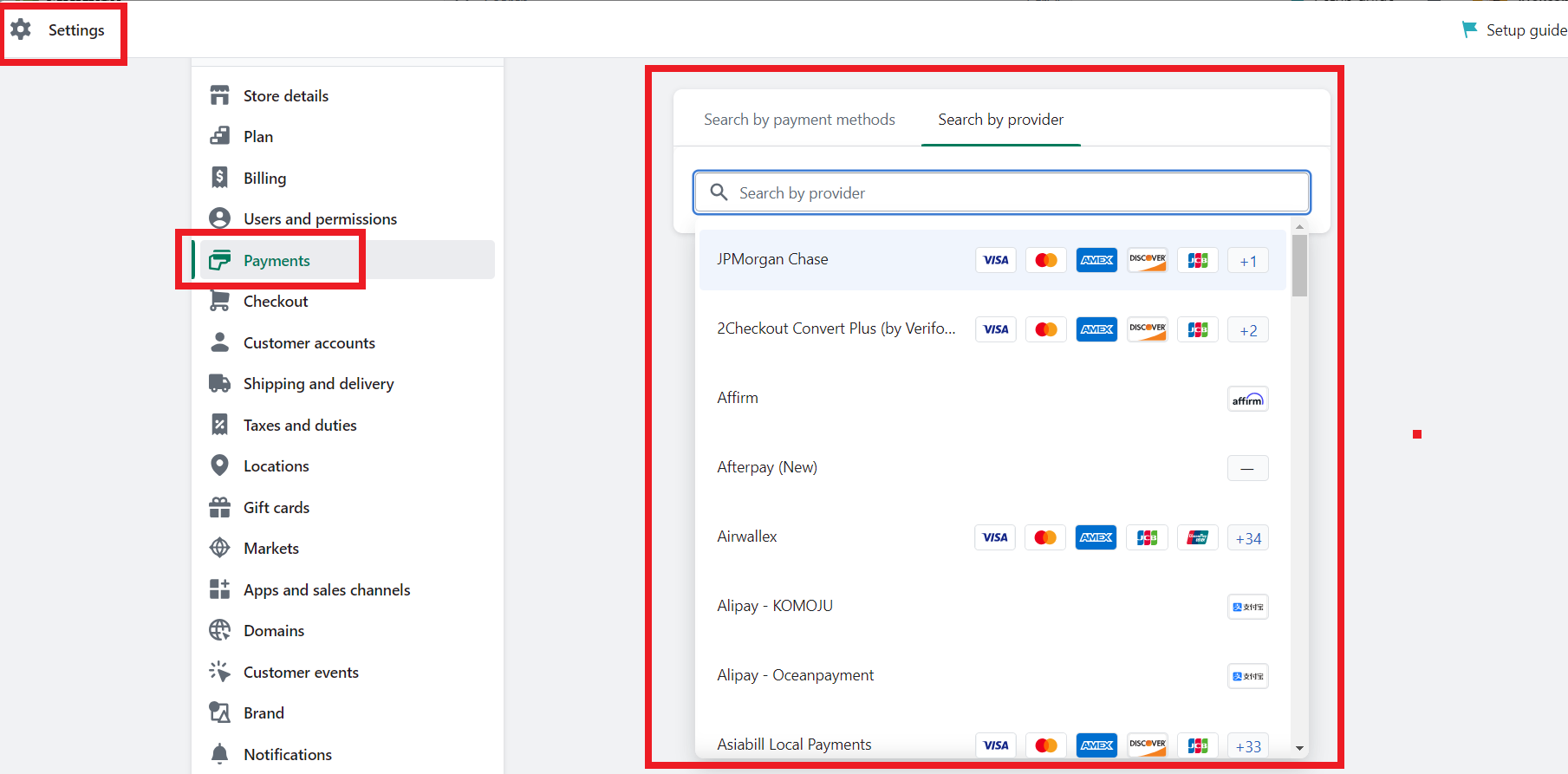
Shopify easily connects with over 100 different payment gateways, allowing you to smoothly accept payments from your customers.
So, here are the fees you might encounter when using Shopify:
- Basic Shopify Plan: A transaction fee of 2.9% plus 30 cents per transaction. Additionally, there’s an extra 2% fee for transactions processed through a payment gateway other than Shopify Payments.
- Regular Shopify Plan: A transaction fee of 2.4% plus 30 cents per transaction. However, there’s an additional 1% transaction fee for using a payment gateway other than Shopify Payments.
- Advanced Shopify: A transaction fee of 2.4% plus 30 cents per transaction. Moreover, there’s a per-transaction cost of 0.5% when using a provider other than Shopify Payments.
- Shopify Plus Plan: A lower transaction fee of 0.25% per transaction.
👉 Learn about Shopify Conversion Rates: A Beginner’s Guide (2024).
PrestaShop Vs Shopify: Pricing
Next on my Prestashop vs Shopify comparison is their pricing structure.
PrestaShop Pricing
With PrestaShop, you don’t have to worry about subscription expenses because the platform is free to start your online store.
However, you’ll need to budget for other costs like your domain name, hosting, and SSL certificate for your e-commerce site.
For example, Hostinger offers various PrestaShop Web Hosting plans, each featuring a free domain:
- The Premium Shared Hosting plan ($2.99/month) provides 100 GB SSD storage.
- The Business Shared Hosting plan ($6.99/month) offers 200 GB SSD storage.
These hosting plans also include a free SSL certificate, so you don’t have to buy one separately. Also, there are transaction fees as well, depending on the payment gateway you use. Thus, they vary between 0.5% up to 3.5% plus €0.35 per transaction.
Moreover, it’s essential to consider potential extra charges when using PrestaShop. These additional fees may vary depending on the services or modules chosen to enhance your online store’s capabilities.
Shopify Pricing
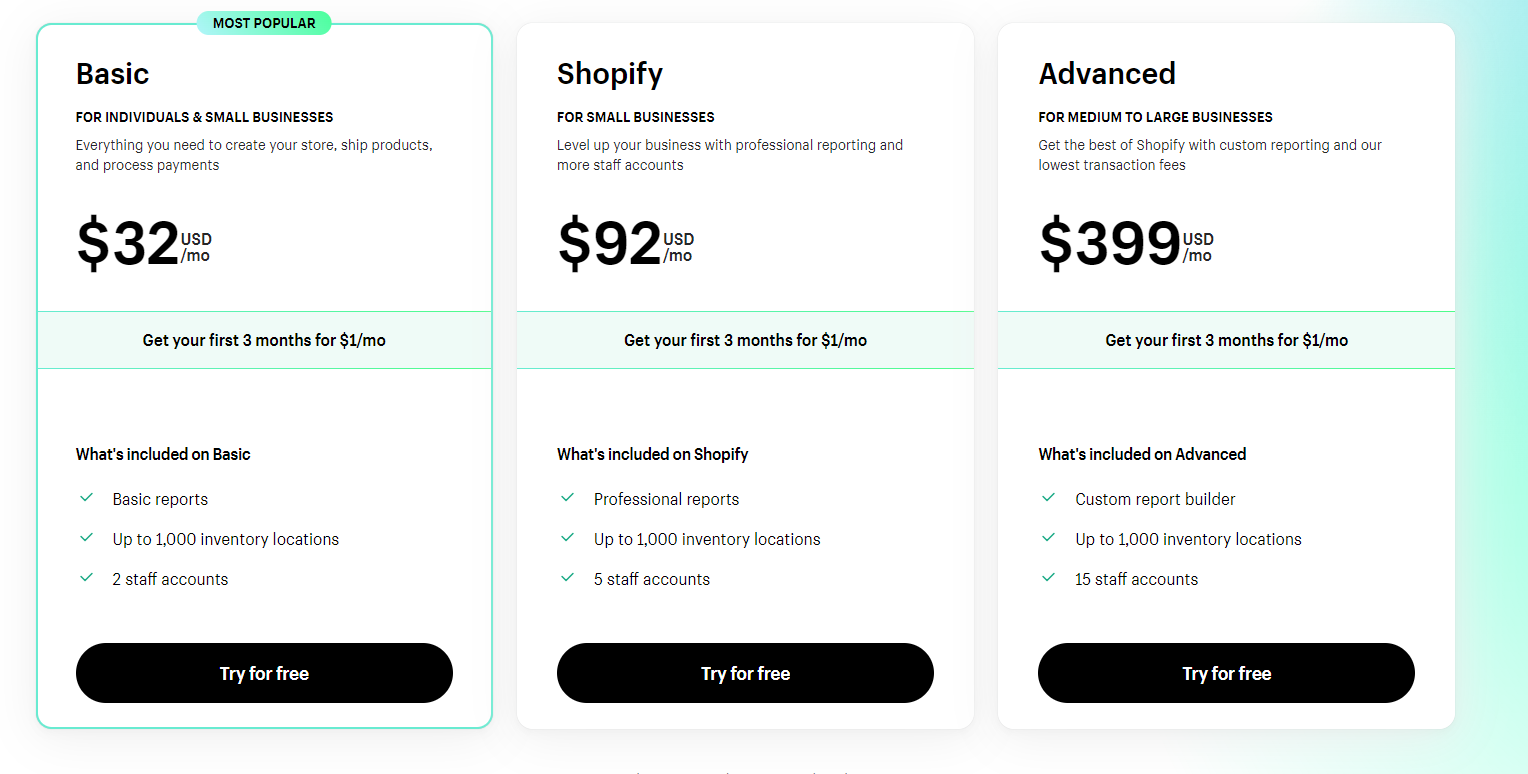
Shopify offers three main pricing plans along with a 14-day free trial. Additionally, there are two other pricing plans available: one at $1/month for three months and Shopify Plus, which costs $2000/month.
Now, let’s delve into the details of the three main Shopify plans.
👉 Check out my in-depth review of Shopify Pricing Plans: What’s The Cost Of Dropshipping With Shopify?
Shopify Basic Plan – $32 per month
This plan provides a variety of features, including the creation of an online store, website customization, and the addition of a shopping cart. It also allows for up to 1000 inventory locations. Moreover, you can expand your sales to social media platforms like Instagram and Pinterest, as well as marketplaces such as Amazon, eBay, and Google Shopping.
Furthermore, it includes functionalities for recovering abandoned carts, fraud analysis, and 24/7 support. You can also have 2 staff accounts and accept credit card payments through Shopify’s payment gateway or a third-party gateway. Additionally, it includes 1 public hydrogen storefront.
This pricing plan is recommended for small to medium-sized businesses looking for more advanced features compared to the Shopify Lite plan.
Shopify Regular Plan – $92/month
The Shopify Regular Plan includes all features of the Basic Shopify plan and offers additional functionalities suitable for businesses with a larger volume of sales. These include the ability to establish up to five staff accounts, advanced report creation capabilities, and real-time carrier shipping options.
Additionally, it incorporates the “gift cards” feature, allowing customers to purchase gift cards for your store. Access to “Professional Reports” provides comprehensive insights into sales, inventory, and customer data. The plan also includes eCommerce automation to automate manual tasks and expand your dropshipping business.
This plan is highly recommended for businesses experiencing a higher volume of sales and requiring more advanced inventory management and shipping options.
Shopify Advanced Plan
This package contains all features of the Basic and Regular plans, along with additional advanced functionalities. These include establishing up to 15 staff accounts, advanced report generation, and real-time carrier shipping, duties, and import taxes.
Moreover, it grants access to the “Advanced Shopify” feature for computing and documenting shipping rates, taxes, and discounts.
This plan is ideal for businesses generating significant sales volume and having complex requirements in inventory management, shipping, reporting, and calculation of shipping rates, taxes, and discounts.
Prestashop Vs Shopify: Pros & Cons
Prestashop Pros and Cons
Shopify Pros & Cons
Which Platform Is Better Choice For Dropshipping & Why? (My Opinion)
When it comes to dropshipping, Shopify stands out as the clear winner over PrestaShop. Shopify offers a comprehensive solution for businesses of all sizes, thanks to its vast app selection and user-friendly interface.
One of the key advantages of Shopify is its built-in CMS and blog system, which allows for easy optimization for search engines. This feature enables you to create engaging content and attract organic traffic to your store, establishing your brand’s authority in your niche.
In terms of domain setup, Shopify simplifies the process by providing a free subdomain for your online store and offering the option to purchase and link a custom domain directly within the platform. This streamlined approach contrasts with PrestaShop, which requires users to find and purchase their domain separately, adding unnecessary complexity to the setup process.
Additionally, Shopify excels in payment processing with its built-in payment processor, Shopify Payments. This eliminates the need for extra setup or incurring additional fees, providing a seamless transaction experience for both merchants and customers. In contrast, PrestaShop users must set up payment processors or rely on third-party gateways, adding unnecessary complexity to the payment process.
Furthermore, Shopify offers convenient email marketing integration through Shopify Email, providing ready-made templates and easy customization for marketing emails directly from the platform. This feature is lacking in PrestaShop, where users must rely on third-party tools for email marketing campaigns.
Lastly, Shopify provides robust reporting and analytics for detailed, customizable sales reports, offering valuable insights into business performance. While PrestaShop also offers reporting features, achieving similar flexibility may require extra modules or adjustments.
Also, I must say that PrestaShop offers far more flexibility for customization. But, this comes with a learning curve.
Here’s an overall opinion.
In my opinion, both platforms offer excellent features for running an online business, but the better choice depends on your specific needs and preferences.
So, whether you prioritize flexibility and customization – use PrestaShop. On the other hand, if you are looking for ease of use and built-in features – Use Shopify.
Conclusion
In conclusion, my exploration of PrestaShop vs Shopify has shed light on the key factors influencing dropshippers’ platform choices.
While PrestaShop offers flexibility and customization, Shopify emerges as the preferred option for dropshipping ventures. With its user-friendly interface, built-in CMS, and seamless payment processing through Shopify Payments, Shopify simplifies the journey for entrepreneurs.
Additionally, its robust email marketing integration and comprehensive reporting tools provide invaluable insights into business performance.
While PrestaShop holds its own in terms of customization, Shopify’s all-in-one solution and ease of use make it the clear winner for dropshippers seeking efficiency and scalability in their online ventures.













![The Top 21 3PL Companies Compared [2025 List & Guide]](https://images.weserv.nl/?url=https://prod-dropshipping-s3.s3.fr-par.scw.cloud/2024/03/Frame-3922469.jpg&w=420&q=90&output=webp)